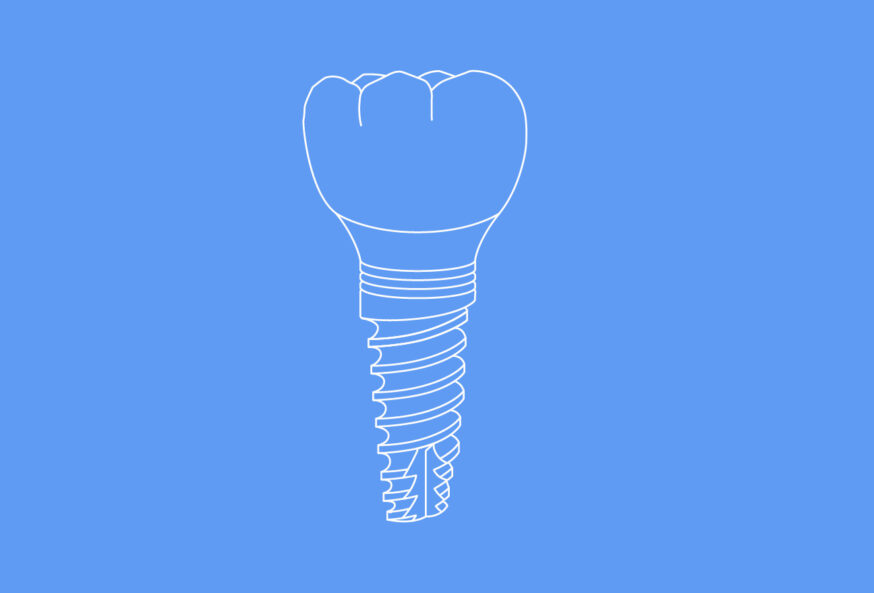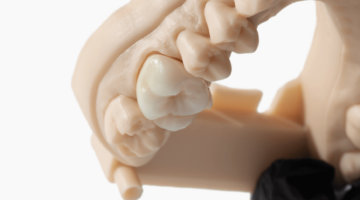Dental digitalism is transforming the way dental implant treatment is crafted and performed. Compared to conventional analog methods, intraoral scanners make the entire implant dentistry workflow cheaper, faster, and more accurate.
Digital impressions enable dental clinics to reduce the total number of appointments an implant procedure will take and the time each appointment takes from both the implant dentist and the patient’s day. The result is better patient experiences and outcomes.
But what does the tooth extraction and implant surgery timeline look like with Dandy?
Here’s how a fully-digital dental lab could accelerate the process by weeks, if not months while ensuring total recovery from the procedure.
What Is the digital implant timeline?
Each patient case is unique. Generally, every tooth extraction and implant placement go through the same motions. However, each patient’s dental implant procedure could range from a two-appointment visit to a multi-year-long regimen.
The timeline largely hinges on the severity of the case. If the process requires bone grafting, the dental implant timeline will be significantly extended. Bone grafting is especially time-consuming, taking approximately four to 12 months to complete.
Further, using analog processes to make the implant can take two months for even a simple implant procedure to finish. However, opting for digital dental implant workflows will significantly speed up the timeline. CAD/CAM technology can compute the ideal treatment plan based on the intraoral scan that accurately records a patient’s bite. Paired with a dedicated dental lab that can create quality prosthetics, your turnaround time to seat the crown will be quicker for patients.
Mild to moderate cases
No matter the case, the first step of the dental implant process begins with a comprehensive pre-surgical exam. This typically involves performing X-ray scans, reviewing the patient’s health history, and taking impressions.
If the bone structure appears healthy, the digital implant workflow will generally proceed through the following checklist:
- Chair side scan – The dentist scans the patient’s mouth with an intraoral scanner. The high-tech device takes a digital impression in a fraction of the time of the analog method, automatically registering the size and shape of each tooth and then transforming that data into a detailed 3-D image of the patient’s mouth.
- Case submission – The case is submitted to the digital dental lab with the orders for the crown and custom abutment as well as the digital impressions.
- Lab review – The lab confirms that the scans are functional. If not, they can ask the dentist to rescan the patient’s mouth right then and there. But if they are, they can prepare the digital wax-up, making any adjustments necessary to ensure a perfect fit. This digital wax-up is then sent back for the dentist’s approval.
- Manufacture – The crown, abutment, and model are manufactured and shipped.
For the next appointment, the patient can have both the extraction and implant dentistry performed on the same day.
Serious cases
If the bone structure isn’t healthy, whether due to bone loss or infection, the implant treatment won’t be able to be placed on the same days as the extraction. Instead, you may need to perform a bone graft to restore the original bone volume, resulting in delayed implant placement. Additionally, the patient may require additional procedures prior to receiving the implant.
If the patient requires a bone graft, the process’ checklist will occur over a much longer timeline:
- The dental surgeon performs a pre-surgical exam to determine the extent of the procedure. Note that if there are pre-operative surgeries necessary before the bone graft, that will extend the expected timeline.
- The dental surgeon performs the procedure, adding the bone graft material to the implant location.
- The patient will have to wait 4-6 months for that implant site to osseointegrate.
- After the bone graft has been deemed successful, the dentist will set a time to surgically affix the implant into the jaw bone. Depending on the case, the implant may be submerged beneath the gum for healing or be non-submerged and covered with a healing cap.
- Once more, the patient may have to wait 4-6 months for the dental implant recovery process to complete.
- After the implants are integrated and the mouth healed, the dentist will take a final digital impression of the upper and lower jaw, perform color matching, and record the bite.
- The digital case will then be submitted to the lab, where the same design and manufacturing process for mild to moderate cases would be performed.
- Finally, approximately 10 days later, the patient would return to have the final implant placed.
Comparing conventional methods
Dentists that opt for the analog impression implant process should expect the timeline to be weeks or even months longer. That’s because the traditional workflow is much more involved:
- Ordering parts – The dentist orders the parts for the impressions, which includes purchasing impression coping for analog, light body impression material, heavy body impression material, and trays.
- Taking physical impressions – The dentist must prep the proper materials and then perform the impression. Here, they have one of two options:
- Use an open tray, which is faster but less accurate
- Use a closed tray, which is slower but more accurate
By and large, patients do not enjoy either option, especially those with a strong gag reflex. Even if the entire process goes off flawlessly, it tends to take up a significant amount of chair time.
- Shipping to the lab – The dentist takes the physical impression and ships it to the lab. During transit, the impression could be damaged or lost, which would reset the timeline.
- Soft tissue modeling – After receiving the impression, the lab fashions a soft tissue model. They have to properly pour it, use the proper mixing ratios, and allow it to set.
- Scan and design – The lab then needs to bring that analog impression into the digital world using CAD/CAM technology to design it.
- Milling – The final product is milled.
- Shipment – The case is then shipped back to the clinic.
Every one of these steps increases the room for error that could lead to an inaccurate restoration, which would land you firmly back at square one.
For instance, if the lab receives the impression and determines that it is defective—an all too common scenario—they’ll request the dentist to retake the impression. As a result, the dentist would have to book an entirely new appointment to take yet another physical impression.
Conversely, if the lab deems the impression usable despite inherent flaws, that could result in a final implant product that doesn’t fit properly. Should that occur, the dentist will either have to make adjustments or request an entirely new implant from the lab.
But, with Dandy’s digital implant workflows, the lab team could request a new scan immediately—without the patient ever leaving the chair.
Dandy—streamlining the tooth extraction and implant timeline
The tooth extraction and implant timeline have dramatically changed with the adoption of digital dental workflows that make the dental implant surgery process faster, cheaper, and more accurate. With Dandy’s digital implant process, there’s less back and forth, less room for error, and fewer steps involved.
Technologies like intraoral scanners and CAD/CAM software enable dentists to take weeks, if not months, off the tooth extraction and implant timeline, especially for more severe cases that require multiple impressions.
Put simply, equipped with Dandy solutions, you can reduce both patient chair time and average wait times between appointments—increasing your office’s efficiency and your patient’s satisfaction.
Sources:
Science Direct. Osseointegration. https://www.sciencedirect.com/topics/medicine-and-dentistry/osseointegration
John Hopkins Medicine. Bone Grafting. https://www.hopkinsmedicine.org/health/treatment-tests-and-therapies/bone-grafting
Dental Economics. Overcoming the Fiscal Drain of Repeating Final Impressions. https://www.dentaleconomics.com/science-tech/impression-materials/article/14039924/overcoming-the-fiscal-drain-of-repeating-final-impressions



